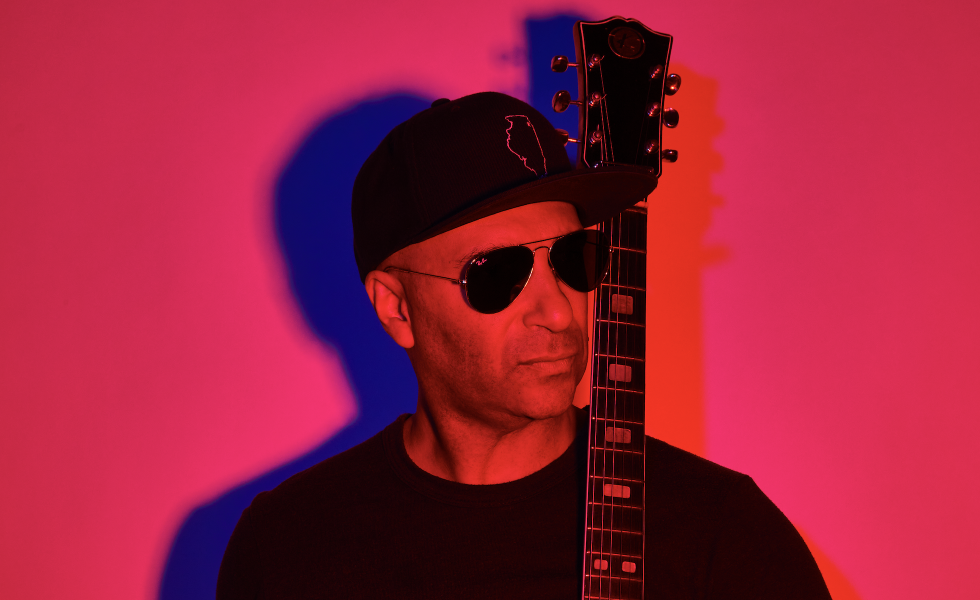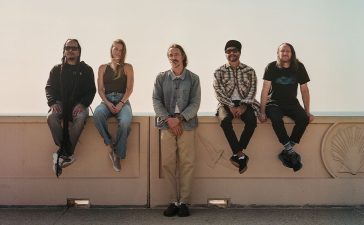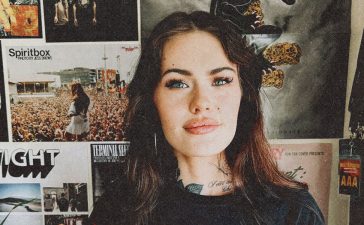If there’s one thing we’ve learned over the past 18 months, it’s that we have two choices in this life: stand by and let the world do its thing, or take that bull by the horns and guide it where you need to. For living rock legend Tom Morello, the journey to embracing the latter couldn’t exist without the former.
“[I’ve had] such a motor on me, and this almost manic energy of creativity, from the time I was a teenager. And to just have to stop was just… I still am wrestling with what that means and what it meant and how to deal with it”.
Morello is no stranger to fighting in the face of adversity, though, nor to leaving lasting impressions with his raucous musicianship. “I’m a guitar player! And no one’s coming to save me. So I just had to find a little bit of that redemption myself, you know, work it out by finding these friends around the globe who want to make music”.
Enter: The Atlas Underground Fire – a collaborative, genre-bending collection of music led by Morello and a diverse cohort of the music industry’s finest. The record is a time-stamp reflective of the turbulent and chaotic climate of the last 18 months, and takes its listeners on a 12-track journey through equal measures of desperation and ferocity. It is an unapologetic exploration of the future of the electric guitar.
Sitting with BLUNT to discuss the conception of the record, Morello talks with pride and a sense of conviction about the damn delicious fruits of his, and his guests’, labour.
I’m loving the riff-heavy-EDM fusion of this whole record. Did you have a vision before going in to write, or was the progression more organic?
I did have a vision writing this. I did another Atlas Underground record in 2018, and the idea on these albums is to assert that the electric guitar doesn’t just have a past, it has a future [as well]. I’m trying to create this hybrid alloy of uncompromising, big rock n roll riffs and crazy guitar solos, but melding them and creating a seamless alloy with the contemporary sounds and future sounds. So I’m not budging an inch on the rock ’n’ roll power, but at the same time, [I’m] probing the future of what the electric guitar can mean for the contemporary and future generations.
I love that you’ve got an eclectic list of collaborators on this album – which I guess adds to the idea that rather than isolating guitar riffs to one sort of genre, you’re bringing in all these amazing collaborators. Just some of the comments I’ve seen, though – AC/DC being brought up a fair bit – how do you navigate the ruffling of those feathers?
[Laughs] Well first of all, I’m a huge AC/DC fan. I think if aliens ever invaded and challenged our planet to a Battle Of The Bands, I’d put AC/DC forward as our champion and feel very, very good about our chances. I love AC/DC, and the reason why [Bruce Springsteen, Eddie Vedder and I] did [a cover of ‘Highway To Hell’] was very simple – [we all] have a long history with it. I visited and paid my respects to Bon Scott’s grave when we were in Perth. We rehearsed ‘Highway To Hell’ over the course of a couple of days after that – we rocked it with Eddie Vedder in a huge football stadium in Melbourne.
This [album] was recorded during the absolute height of the plague lockdown, and during this time – where we were absolutely isolated and in this completely cloistered, lonely existence – I wanted to harken back to this moment of the greatest kind of tribal connection; where, in that soccer stadium, 80,000 went going absolutely berserk to one of the greatest rock ’n’ roll songs of all time, sung by two of the greatest rock ’n’ roll singers of all time. [It was] that kind of celebration of what it means to live all the way. As Hemingway said, “Live all the way up.” That something – that lightning strike moment in Melbourne – we wanted to capture some of that on this record.
I know everyone would have been dealing with their own shit at the time – Posner was scaling Everest, for example, and DJ Sama was going through what she was going through with bombing raids. Do you think those factors contributed to the integrity of this record?
Oh, absolutely. The short answer is yes. It was a real reflection of the lives of the artists and the collaborators, and with the nerve cell being here, where I was completely alone the entire time. From Palestine to Sweden, to Brazil, to the UK – from Nashville and New Jersey to Jamaica – we’re this group of rock ’n’ roll pen-pals on a global scale, each living our own lives and contending with what we’re contending with on a daily basis, while I’m marching up here dutifully each day, to record some riffs into my phone to send off.
It’s kind of like a message in a bottle, almost. [I’m] sort of lobbing these into the ocean, hoping for hope, at the end of the day, that that’s what will come back. And it did. I’m so grateful to the collaborators on this record. I think in some ways, they don’t really know the great service they did me by providing that connection – that friendship, and that ability to continue to do what I’ve been doing over the course of three decades at a really high level, because of their contributions.
“Each thing has its own kind of universe and its own laws of physics within that universe – and this one has been tied to the laws of physics of this plague…”
I know how important that would have been. What kept you grounded before this all kicked in?
I mean, everybody was figuring it out and dealing with it, and I had never really… [I’ve had] such a motor on me, and this almost manic energy of creativity, from the time I was a teenager. And to just have to stop was just… I still am wrestling with what that means and what it meant and how to deal with it. I had no interest in picking up a guitar. Every day felt like it was 1,000 hours long, and also the general anxiety [stretched] beyond the walls of my home.
Y’know, my 97-year-old mom’s here, my 90-year-old mother-in-law is here, [we have] two kids losing their fucking minds trying to go to school on a screen… All of a sudden a window breaks, and now I’m the window fixer! The plumbing explodes, now I’m the plumber! I’m a guitar player! And no one’s coming to save me. So, I just had to find a little bit of that redemption for myself, y’know, work it out by finding these friends around the globe who want to make music.
The fact that you had such a diverse amount of contributors, is that something you see yourself continuing in the future?
Yeah! I worked on a lot of music during this downtime, and there is more music that I’m very proud of. The one thing that this project has taught me is that with a guitar, a phone and an address book, I can make all the records I want. There’s really no barrier to making music. And this does feel like a chapter – this is kind of like the plague chapter [laughs].
I did a lot of one offs with The Pretty Reckless and K.Flay, The Struts and Dennis DeYoung, and I made two EPs – Comandante and The Catastrophists [with The Bloody Beetroots] – and so what began as an absolute drought, became the most prolific recording time of my entire life. [But I also] look forward to putting a pin in that time and re-entering the world of live performance, and connecting in that way.
Do you think that idea will stay within your own projects, or do you think it could also seep into your other bands?
I have no idea. This is a process and a project that’s married to this particular moment in history, really, and I like that. Each thing has its own kind of universe and its own laws of physics within that universe – and this one has been tied to the laws of physics of this plague. I’m proud of the music that’s happening, and it wouldn’t have happened in another time. It’s reflective of [that] as well. There needs to be an authenticity in order for it to connect, and some of these songs are really tied to those feelings of desperation, y’know?
The Chris Stapleton song [‘The War Inside’], the Bring Me The Horizon song [‘Let’s Get The Party Started’], the Phantogram song [‘Driving To Texas’], the Grandson song [‘Hold The Line’] and ‘The Achilles List’, the Damien Marley song – they’re a continuation. They’re links in the chain of my other twenty albums of songs that are fighting-the-power songs. They’re songs that are, like, not giving an inch and fighting for the world you really want to one day see, y’know? Those anthems… there’s no time to not make those anthems.
Then the third lane, which is no less important than those two, is that this [album] has instrumental music on it, and it’s music that asserts that I am a guitar player. It’s undiluted by any lyrical content. The record starts with ‘Harlem Hellfighter’ and it ends with ‘On The Shore Of Eternity’, and there’s ‘Charmed I’m Sure’ in the middle. You could be expressive with lyrics, but you don’t always need them to make a point.
I’m really glad you said that, because I have a two-year-old running around me 24/7, so I’m always distracted – but listening to the album, the thing that drew me in, away from what I was doing, were those guitar moments. I felt the story that was being told with just the guitar. And I think that’s such a beautiful thing that you can do.
I got a message from a friend today, where they just discovered the song with Bring Me The Horizon, ‘Let’s Get The Party Started’, and they said: “The guitar solo you play in that song is how I’ve felt for the last 18 months” [laughs]. And just to clarify, that guitar solo is messed up [laughs]. It’s the way I’ve felt the last 18 months, too: messed up.
>> KEEP READING: Danny Denial revels in raw punk with a low supply of fucks to give <<
The Atlas Underground Fire is out now via Comandante / Mom+Pop
Click here to get around it










